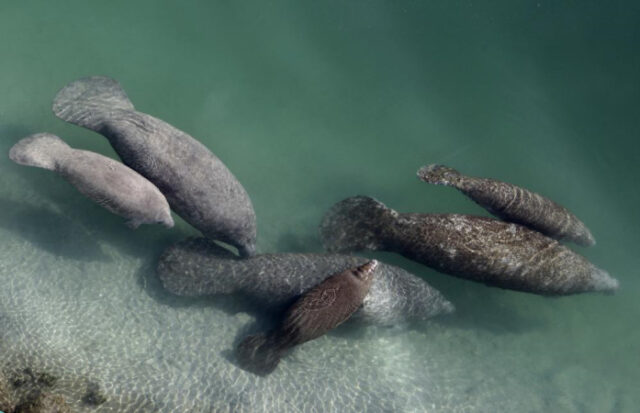
FORT LAUDERDALE, Fla. (AP) — Three conservation groups filed a formal notice on Monday of their intent to sue the Environmental Protection Agency if it doesn’t take steps to protect manatees from water pollution in Florida.
Pollution-fueled algae blooms are cited as the cause of over half of the more than 1,000 manatee deaths in Florida this year, according to a news release from the Center for Biological Diversity, Defenders of Wildlife and Save the Manatee Club.
The algae blooms killed thousands of acres of seagrass in the Indian River Lagoon, which highlights the inadequacy of Florida’s federally approved water quality standards, the groups said in the notice letter.
They are asking the EPA to reinitiate consultation with Fish and Wildlife Service to reassess the standards. Monday’s notice gives the agencies 60 days to address violations alleged in the letter before the groups file a lawsuit.
The Indian River Lagoon is an “ecological wonder that supports not just manatees, but green sea turtles, snook, tarpon and a stunning diversity of marine life,” Lopez noted.
“The mass death of these manatees, which was completely preventable, makes it clear just how critical it is that the EPA take swift action to protect the vibrant ecosystem they live in before it’s too late,” Lopez said.
The Indian River Lagoon includes important warm-water habitat for slow-moving mammals and supports more species of plants and animals than any other estuary in North America, the groups said in the news release.
They claim that despite “extensive evidence of that harmful pollution and Florida’s failure to address it,” the EPA approved the state’s water-quality criteria for nitrogen, phosphorous and dissolved oxygen.
“Until Florida is forced to rein in its rampant pollution, manatees will continue to die slow, agonizing deaths by starvation every winter,” Lindsay Dubin, staff attorney at Defenders of Wildlife, said in the release. “The EPA must act immediately to improve water-quality standards lest it further jeopardize the future of this iconic species.”
Last week, wildlife officials announced a pilot feeding plan that could save many manatees from starvation. However officials said manatees will still face the long-term threat of manmade water pollution stifling their food supply.
The program has not been tried before.
Manatee deaths in Florida this year are more than double the average annual death rate over five years, officials said. The deaths represent 19% of the Atlantic population of Florida manatees, and 12% of all manatees in Florida.
Manatees were downlisted from “endangered” to “threatened” in 2017, but since then they have suffered significant setbacks from habitat degradation, red tide, unusually cold winters and now potential starvation from the seagrass die-off.
Republished with permission[/vc_message]












